Over the last two years, I have had the tremendous privilege of being a student at Freestyle Academy. Freestyle became such an important place to me and it became the thing I was waking up for in the morning. School became exciting and I had been handed a community that I would not trade for the world. I learned more than I ever could have imagined. Beyond the class curriculum; beyond what I was taught. I learned how to express myself in different ways. How to express myself through my art, my writing, and even just how to throw a hint of my personality into everything I made. I learned to create for me and not for the grade, and that there truly are no mistakes in art if you work with an open mind.
Mental Health in Adolescents
Scroll to the bottom to see the final!
Even though our junior year got cut short, and the documentary project was nothing like it was intended to be, I don’t think I could be prouder of the outcome.
For years I had been so invested in learning about mental health and the real effect it has on kids my age. Even when I was younger, I would hear the word disorder being thrown around and every adult was PUSHING for advocacy of mental health, but I never faced it myself. Going through this process opened my mind to how grateful I am to not have dealt with this seeing how common it is amongst the people in my communities, and all I ever wanted to do was help as best I could.
When we were introduced to the documentary unit, there was nothing else i could have imagined doing. Ms. P and I went back and forth for days trying to come up with a sufficient list of photography subjects I could use throughout the book.
The Idea and the List
For my documentary project, I want to focus on the rise in mental health issues in adolecentes. Living in the bay area, especially, we are faced with a lot of societal and home pressures about school and college. Plus, with everything that went on this year for us, I want to bring awareness to the fact that it is real and it is happening. I don’t want my documentary to be just a profile but an informational topic.
- Psychology Textbooks
- Messy room (Real)
- Sleep tracking app (Sleeping too much, sleeping too little)
- Food tracking on plates (Overeating, undereating)
- Small “Get Help” Posters
- Medicine cabinets and bottles
- Shaking legs/biting nails
- Diary/notebook of feelings
- A passion that someone uses to cope (Guitar)
- Something that triggers stress (Finals Schedule)
- Group therapy center (Empty chairs in a circle)
- Mobile Stethoscope
- Stress balls/anxiety toys
- Someone holding their chest while experiencing palpitations
- Caffeine
- Yoga
Process
Now it was time to start working on the real thing. We wrote a 8-10 page paper for our English class and we used Adobe Indesign to create the magazine in Design.
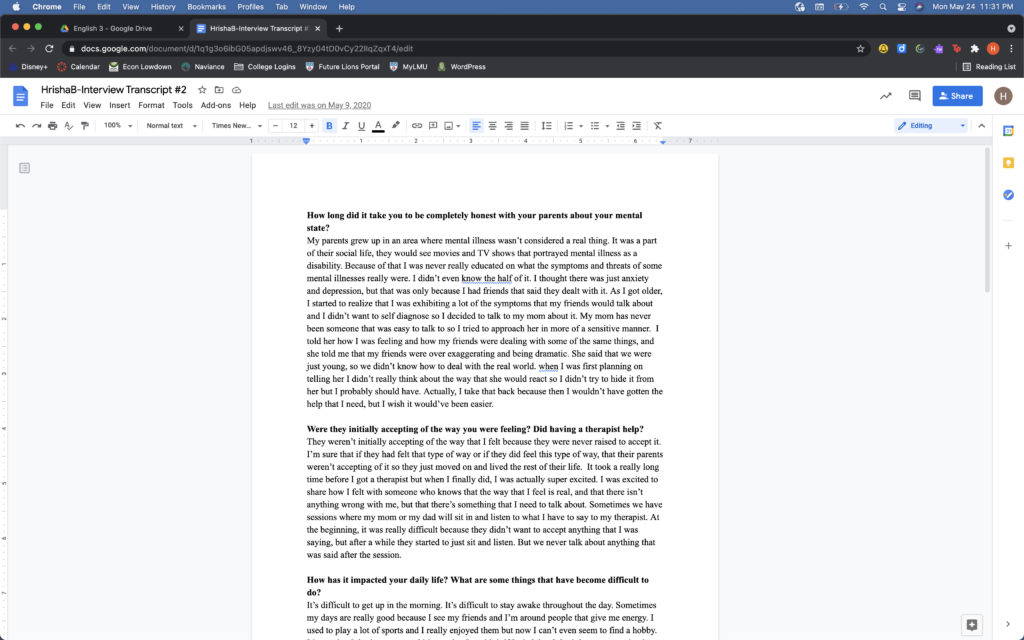
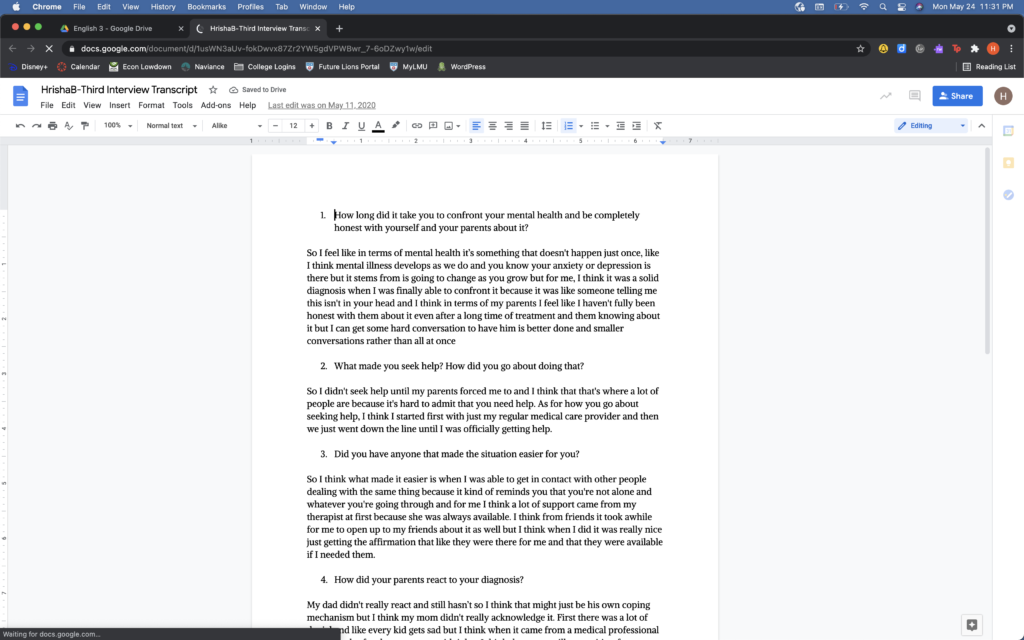
We did a total of three interviews for our paper in English. I interviewed Nilija Fulumbarker (a psychologist friend of mine), Sophia Mirrashidi, and an anonymous source.
We also had to make a few graphic design elements to match the text of the pages and bring out the creativity in it.
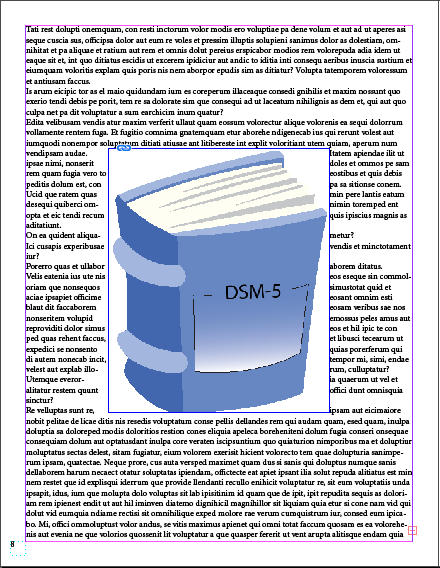
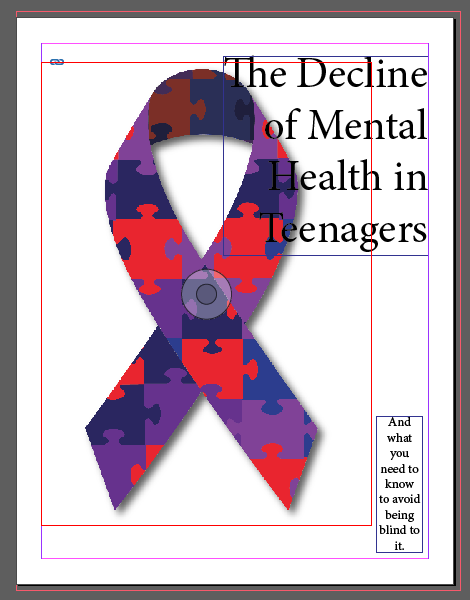
Slowly, we started to piece the final project together.
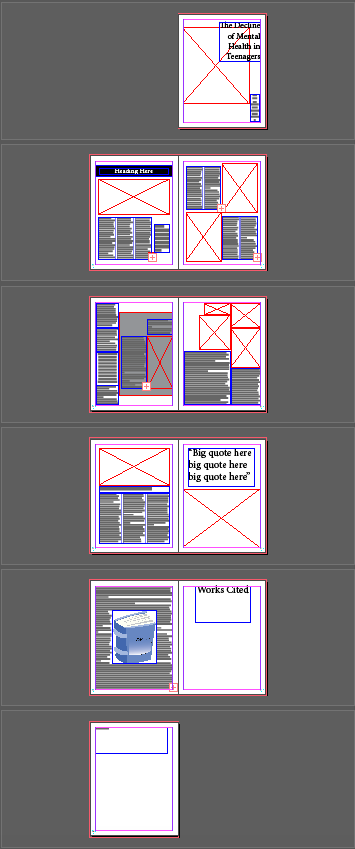
The Essay
In case you’d like to read it on it’s own 🙂
Mental Health in Adolescents
As the sun comes up for another long school day, a teenage girl rolls herself off of her bed knowing that it is the only way she will get up in the morning. As the chirping of the birds creates a peaceful background, she makes her way to the bathroom, making direct eye contact with her reflection. Her resting face reminds her of the world she lives in. She is numb to her daily routine. The only goal is to get through the day. As she gets in her car, the sound of the engine revving assures her that the next twenty minutes of her day will be dedicated to herself. She connects her phone to the auxiliary cord and begins to blast her favorite playlist.
After getting through a day she had lived through a hundred times before, she makes her way to tutoring. Hours pass and she gets back in her car to finally make it back home. She inserts the key into the ignition and starts to twist it. One click. Then, another. The radio starts to play and her high beams flash in the dark, but just before the engine is started, she stops turning the key. Slowly, letting go, the tears start to build in her eyes. Now, the sound of the engine was no longer one of peace, but the last sound she would hear before she started to feel unsafe.
Mental health encompasses both psychological and emotional wellness, which are critical at any stage of life. When a person has positive mental health, they perform better in the real world. They will avoid the chances of depression in the future and they are guaranteed to persevere through any and all possible curveballs that life has to offer. When a person struggles with negative mental health, negative emotions can often interfere with their daily life. Tasks become very difficult to get done when someone begins to lose energy and passion for the things they do regularly. It is very common for these negative thoughts and emotions to surface while a person is in their adolescent years. Teenagers and young adults will frequently see signs of negative mental health in others and perhaps themselves. That is not to say that young children and elders will not suffer from these obstacles, but the signs may look different.
Living in a society that runs solely on competition and pressure is a difficult endeavor for anyone, but when you are already fighting a battle with yourself, it can be even harder to see the light at the end of the tunnel. Over the years, mental health has become a popular point of discussion among teenagers. Countless teenagers are seeing a therapist and/or are on medication for their condition, but what is it really like? Adults are constantly being told to look for the signs and seek necessary help without knowing the gravity of the situation.
There comes a time when someone is fighting a battle alone and all they really need is some backup. Oftentimes, an individual will develop some sort of mental health condition in their teenage years or in their twenties, so it is common that they will be living with their parents when issues arise. Throughout the course of my research, I interviewed a sixteen-year-old girl struggling with both clinical depression and anxiety who prefers to remain anonymous.
“My parents grew up in an area where mental illness wasn’t considered a real thing,” she said baldly. Being born into an immigrant family, it was never easy to mix her ancestors’ culture with the culture she had been raised in. Both her parents were born and raised in India, where mental health is finally becoming a discussable topic, but it is still not widely accepted. Unfortunately, thousands of children who struggle with depression and/or anxiety have parents that don’t believe in these conditions. The upbringing of these parents will carve the way their children are raised, and it can often result in several consequences. These consequences include low self-esteem, difficulties with boundaries, anxiety, weak coping mechanisms, and depression.
While describing an exchange she had with her mother, she said, “I told her how I was feeling and how my friends were dealing with some of the same things, and she told me that my friends and I were over-exaggerating and being dramatic.” Conversations such as these allow insecurities to arise within the child. As soon as a parent hints at any type of invalidity, the child will feel alienated and be driven into closure. This is where we see a struggle with coping mechanisms and self esteem. A child’s parents are the two people who are supposed to love, support, and validate their children, and if it happens that the parents don’t believe in their child, it makes it extremely difficult to have the child believe in themself.
Aside from the facts, the most thought-provoking component of a negative mental state is a person’s daily life. The good days versus the bad days. For better or for worse. You’ll hear experts say that every individual goes through life differently, but what have you heard from an individual going through it. “My bad days are really bad and my good days are really good. I have days where I can barely get myself to do anything. I can’t even find the energy to wash my face or walk downstairs to get food, or go for a walk, or do my late assignments, or take a shower, or brush my teeth. I know that sounds really gross but that’s how those days go. My good days are usually the days where I’m not at home and I’m out with my friends. I’m a very extroverted person but it’s really hard to prove that when there’s always something bringing me down,” my interviewee answered when questioned. “My anxiety comes up a lot at school so then school doesn’t become an enjoyable time for me away from home either and there are days where I will have an anxiety attack in the bathroom and go home before lunch even starts. I’ve cried while driving home from school because I just don’t want to be there.” It is not unusual to hear this from a teenager. After being invalidated by her parents and convinced that her issues weren’t nearly as significant as the next person’s, any listener would confidently conclude that she should not be expected to feel safe in her own home.
The only way to successfully make a difference is to make certain that every party is educated properly. Secure the parents’ support and seek a professional for help. A third party, such as a therapist, is essential in helping the client process their feelings thoroughly. Fortunately, my interviewee was introduced to a psychiatrist relatively early on and was able to make real change after being given a diagnosis. “It took a really long time before I got a therapist but when I finally did, I was actually super excited. I was excited to share how I felt with someone who knows that the way that I feel is real, and that there isn’t anything wrong with me,” she explained. “I always knew that there was something wrong, or not ‘wrong’, but I knew that how I was feeling wasn’t the norm. Although, I do feel better knowing that there is a label for it.” She continued to cover every inch of her story, and how the security of labeling her condition made sure that she wasn’t as alienated as she had once believed.
Everyone is going through something completely different, and because of this, most teenagers are extremely hesitant to believe that anyone could understand what they are dealing with. It is important to encourage them to seek help from a professional in order to get a real diagnosis and to have a trusted adult that is familiar with your mental state. However, you will most likely find them confiding in their friends and classmates. In a 2019 article published by the National Alliance on Mental Illness, Shianna Ali explains the impact of friendships on mental illnesses: “All friends need support at one time or another…Helping others is shown to make people happier and can even help reduce symptoms.” It is ordinarily found that two people dealing with similar circumstances will come together in order to aid both of their needs. Ali continues, “If your friend does have a diagnosis of their own, this similarity could bring you closer together; you can each discuss your symptoms and try coping mechanisms together.” Two people possibly bonding over the feeling of being alienated their whole life can alleviate the feeling on both sides as a whole.
“I am so hopeful because the younger population is making it “cool” to talk about your mental health,” exclaimed Nilija Fulambarker when asked about the future of mental health. Nilija is a psychologist who currently works at Goal Oriented Academics and Learning Sciences, also known as G.O.A.L.S, as the director of education. She is in constant contact with students from all over our area. Aside from her daily work, she loves to work one-on-one with as many teenagers as she can. Whether it be help with biology or their personal lives, she always makes sure that she is open, patient, and attentive.
When questioned about her view on adolescent’s coping strategies, she noted, “My general observations from working with lots of teenagers is that they are very dependent on their friends for validation and advice on their mental health issues. I find it rare when parents and teenagers are on the same page about what is going on in teenagers’ lives” (Fulambarker). Giving teenagers the room to grow and reach out to various resources has proven to be tremendously effective as long as their conditions are also improving. Leaving them stranded could result in them being in the same position as where they once started.
Parents, evidently, play the biggest role in a child’s life, but it can be an exhausting task when one of them is struggling helplessly. Over the years, we’ve seen a remarkable increase in mental health resources. One of which are the editions of the Diagnostic and Statistical Manual of Mental Disorders. The DSM-5 is the most recent edition of these books, and it is used to diagnose patients with the proper medical condition. Every psychologist and therapist is an expert in their knowledge of these manuals, but it is recommended that a parent be as well. It is often hard to get your hands on the DSM-5 because of its incredible cost; nevertheless, there is an endless path of credible and affordable sources that can be helpful. Ignorance is not always bliss, so making certain that every party is aware of effective triggers and possible medications can move the process along.
Caffeine comes in numerous forms. Coffee, tea, energy drinks, and soda are undoubtedly some of the most popular drinks amongst adolescents, and the energy rush is sought out for. The real description of caffeine, though, is that it is a stimulant. Other stimulants are amphetamine and adderall, both of which are highly addictive drugs used recreationally to stimulate the nervous system. Chris Iliades reports for Everyday Health, “caffeine stimulates your “fight or flight” response, and studies show that this can make anxiety worse and can even trigger an anxiety attack. And as with the symptoms of anxiety, one too many cups of joe may leave you feeling nervous, moody, and can keep you up all night.” Being cautious of your triggers or another individual’s triggers will beneficially steer clear of intensifying anxiety-probing environments.
Antidepressants and antipsychotics are types of drugs normally fitted to aiding a patient. Many teenagers with depression are setting alarms to take medications like Lexapro, Zoloft, or Prozac. The intention of these drugs are pure, but a common byproduct is lack of emotion. It is crucial to remember that the solutions to one person’s problems are not the solution to another’s. Being patient with possible medications is key when enabling someone to improve their mental health. Anxiety also comes with a set of difficulties in medication. Many of the same antidepressants treat anxiety and panic disorders very effectively, and can boost productivity in all aspects of a person’s life.
Many parents and children hold an opinion about depression or anxiety that implies an eternal path of trouble. It can be strenuous on the heart to continue imagining a better life for the ones you love without being able to take charge of the changes needed to be made. Keeping up with the real stories of adolescents with mental health conditions is one of the most credible methods one can follow in order to learn more. Sophia Mirrashidi, a sixteen year old girl in the heart of Silicon Valley, is another teenager struggling with balancing her work and social lives with her personal implications. After extensive research done by her parents to find a therapist, Sophia found one she truly clicked with. Soon after, her therapist suggested that she may be dealing with both anxiety and depression, but it wasn’t until October 2019 that Sophia was officially diagnosed. Similar to my first interviewee, Sophia felt as though a “label” was of more help than harm. When asked about her reaction towards her mental state, she responded, “I feel like in terms of mental health it’s something that doesn’t happen just once, like I think mental illness develops as we do, and, you know, your anxiety or depression is there, but it stems from going through change. I think it was a solid diagnosis when I was finally able to confront it because it was someone telling me ‘this isn’t in your head’” (Mirrashidi).
Many teenagers like Sophia tend to downplay their emotions when fighting adversities because they strive to avoid self-diagnosing. In doing this, they are reluctant to seek a therapist since assuming you have a mental illness has become a societal scandal. “I didn’t seek help until my parents forced me to and I think that that’s where a lot of people are because it’s hard to admit that you need help,” Sophia continued. Oftentimes, all it takes is for someone to notice when their loved one is troubled. Offering support and understanding reminds the people in your life that you are an active part of their day. Sophia expressed later that she was quick to include her friends in her Feelings Log at the end of every day because of the gratification she felt towards their efforts. Her therapist urged her to keep a log of her emotions in hopes to give her a physical reminder of the happy and healthy girl she can be. Sophia responded gratefully, “I feel like I’ve made real progress with my therapist and I’m able to apply the coping skills I practice in my real life” (Mirrashidi).
There will always be light at the end of the tunnel, sometimes you just need someone to pull you through. Mental illnesses such as depression and anxiety are not uncommon amongst any age group, and making sure that every human being is working on having positive mental health will be nothing but beneficial to our society. Influences such as social media and societal judgement can worsen these conditions, especially in adolescents. Everyone is an influence on another person’s life, meaning that no signs and symptoms should go unnoticed. If and when you observe a peer losing interest in school or in a sport, no harm can be done in simply asking if they are doing okay. In today’s society, it is easy to forget that no one is perfect. Academically, we are pushed to our limits, and socially, we are convinced that we should look like the people on television.
Since many mental health cases become prevalent when a child is still in their adolescent years, parents often seem to forget the gravity of the impact they have on their children and how a simple “I love you” could possibly be the start to helping and healing. Teenagers need to exist in an environment that promotes both productivity and wellness, if either are out of balance, the passion and energy to complete jobs will slowly disappear. Pursuing professional help has never been and will never be frowned upon by society. Staying updated on recent findings and statistical analysis regarding mental health cases will ensure that a person has the knowledge and capability to take note of the signs and look for proper care. In the last decade, the younger generations have made it a popular topic of conversation, and hopefully it will only continue to become more accepted over time.
The Real Deal

Grind Time
This project was one independent to the design class. We were challenged to come up with a product marketed for a certain audience. We were given freedom of expression as long as it was something we could successfully follow through with while using common advertising techniques in our design process.
I created a coffee brand named Grind Time. It was marketed towards teenagers and the slogan was, “We grind, you grind.” Insinuating that we would grind your coffee beans and you were grind out whatever work you had to do.
I had a severely unhealthy coffee obsession around the time of this project, so I was excited for this one.
Progress Pics
I have so many pictures of the journey so I’m just going to throw them all in here. (Plus a picture is 1000 words so I’m really just about to write you an essay.)


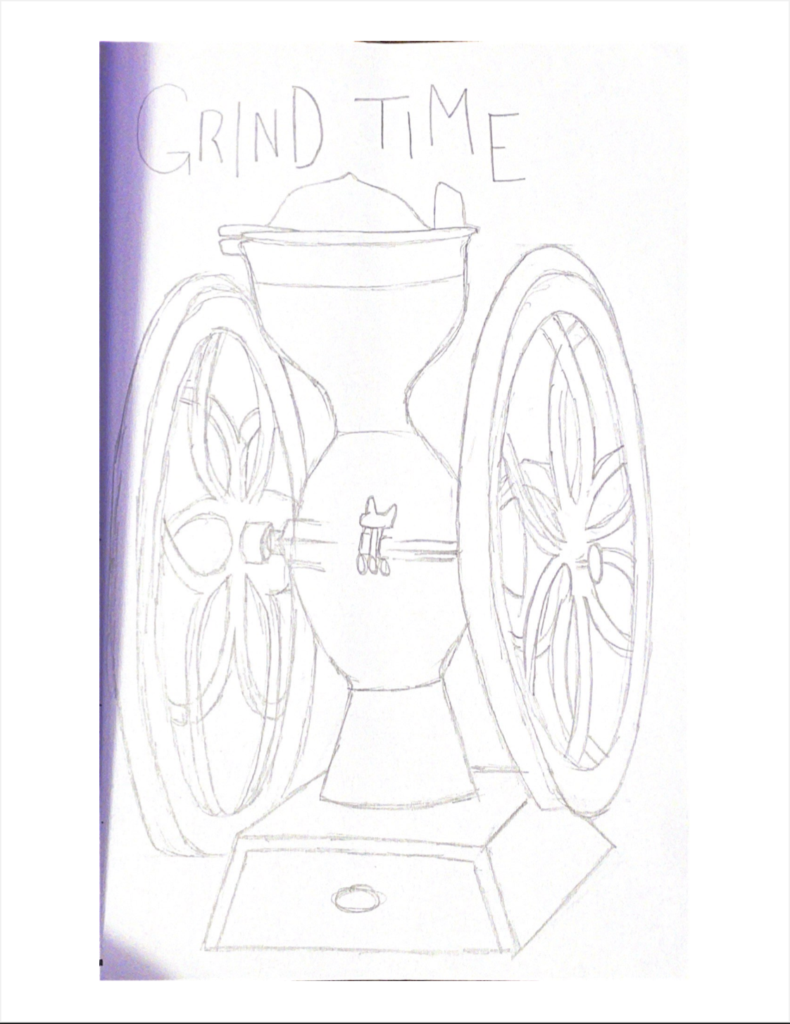

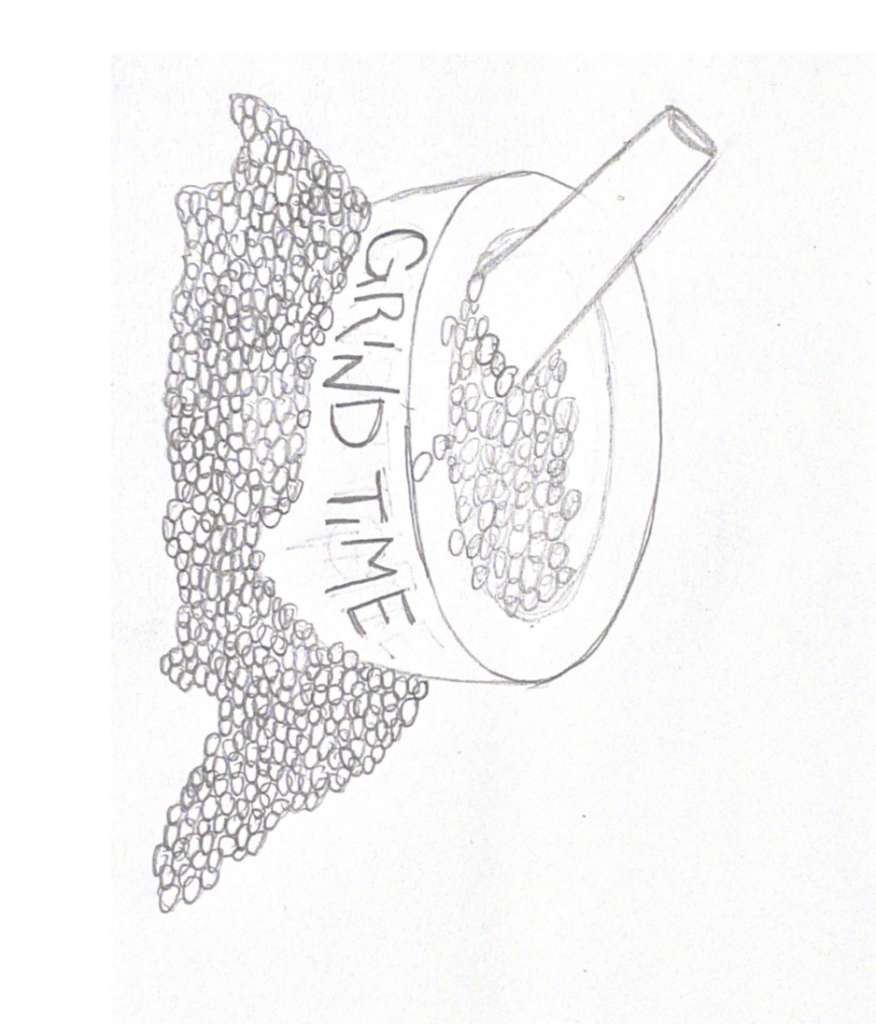
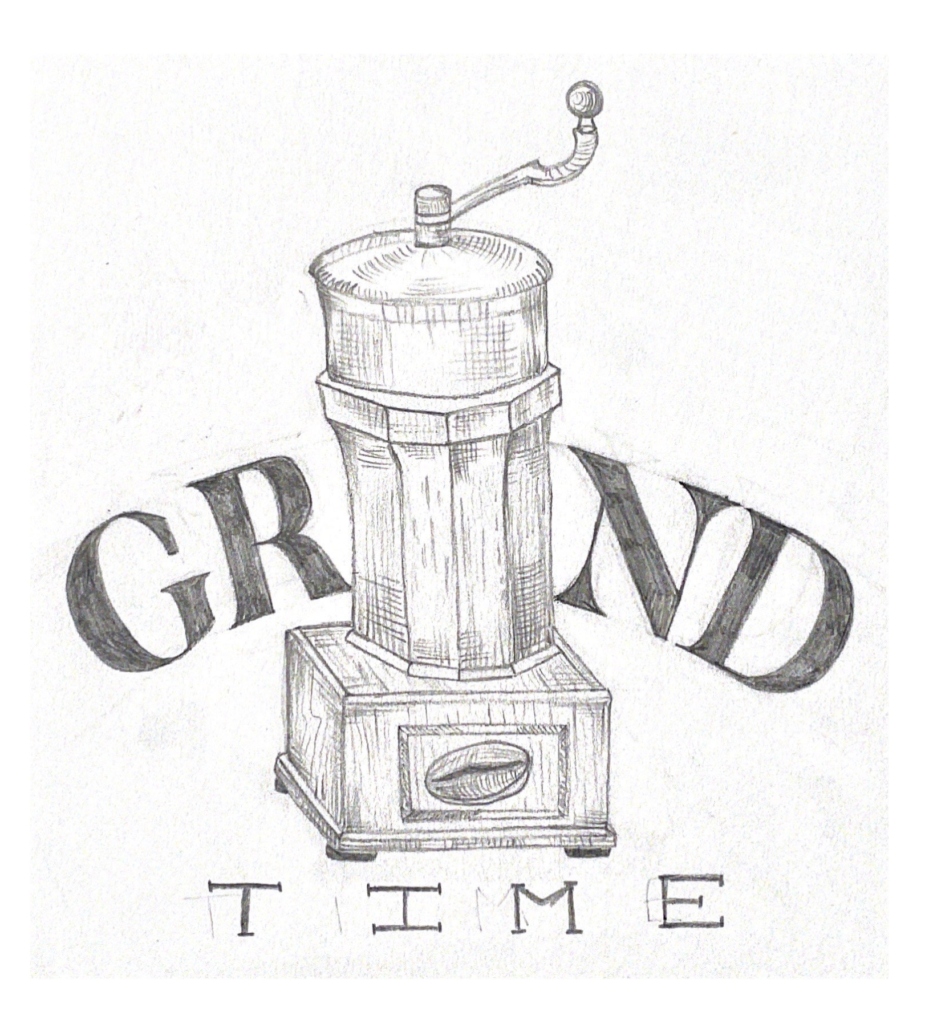

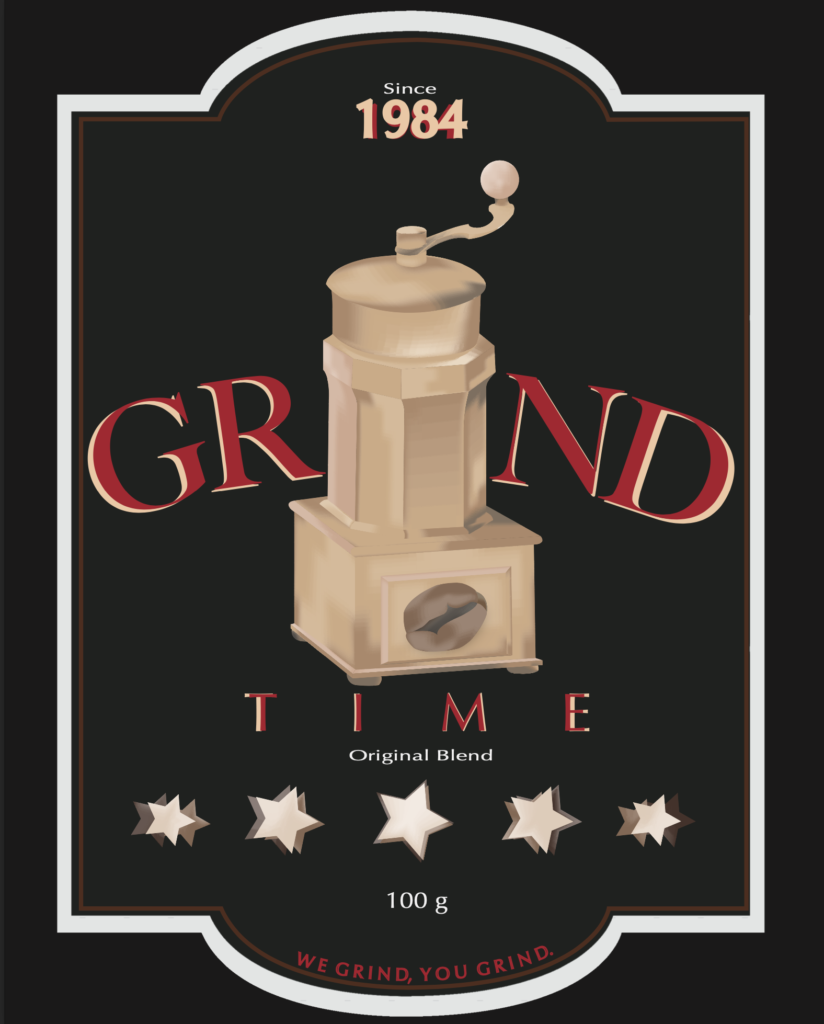

I have come to love the art I’ve produced over the last two years, the good and the bad. These are just two that I will show off for the years to come.
I said it at the beginning and I’ll say it again, I would not trade these last two years for the world. (Even though most of it had to be online.)